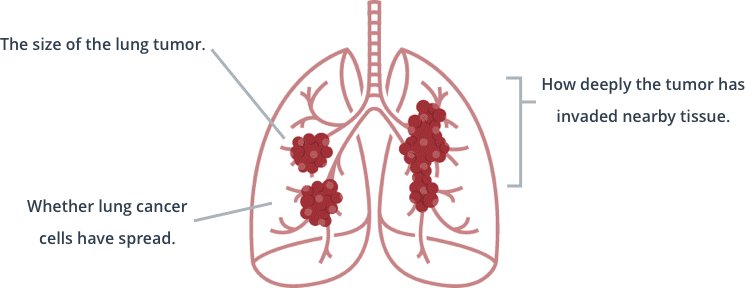What Is Lung Cancer?
Lung cancer occurs when cells in the lung grow uncontrollably to form a tumor. Cancer cells destroy healthy lung tissue and prevent the lungs from functioning properly.
While this type of cancer starts in the lungs, symptoms usually do not appear until the cancer has spread to other parts of the body, and then it is more difficult to treat.(1)
Lung cancer is the leading cause of cancer deaths, killing more people than colon, breast, and prostate cancers combined.(2)
It is estimated that nearly 240,000 new lung cancer cases will be diagnosed in 2023.(3) About 9% to 15% of lung cancers are caused by occupational exposures to carcinogens, including asbestos.(4)
Lung Cancer Linked to Asbestos
People who work or have worked with and around asbestos are many times more likely to die of lung cancer, according to studies of asbestos-exposed workers.(5) Overall, the more a person is exposed to asbestos, the higher the risk of lung cancer. This increased risk is seen with the inhalation of all forms of asbestos fibers.
Most cases of lung cancer in asbestos workers occur at least 15 years after first contact with asbestos. Workplaces where employees may have been heavily exposed to asbestos include places where insulation is used, brake and clutch repair shops, and shipyards. Asbestos may also be found in cement, roofing materials, pipe covering, gaskets, and brake linings. Some older buildings, schools, and homes may contain asbestos, too.

The notion that health effects of asbestos exposure might be linked with lung cancer began to surface in the 1930s. By 1955, it was firmly established that asbestos workers face a “notably higher risk” of developing lung cancer than the rest of the population.(6) In addition, workers exposed to asbestos who also smoke have an even greater risk of contracting lung cancer.(7)
It is estimated that nearly 34,300 people die each year from asbestos lung cancer.(8) Weitz & Luxenberg achieved a landmark $12.5 million verdict on behalf of a mechanic who was exposed to asbestos on the job and later died of lung cancer.
Have you or your loved one suffered complications due to asbestos exposure? We offer a free legal consultation.
Get a Free Case ReviewTypes of Lung Cancer
There are two main types of lung cancer:
- Non-Small Cell Lung Cancer — the most common type of lung cancer, accounting for about 85% of lung cancers.
- Small Cell Lung Cancer — a type of lung cancer that makes up about 10% to 15% of lung cancers and tends to spread quickly.
A third type, Lung Carcinoid Tumor, which accounts for less than 1-2% of lung cancers.(9)
Signs & Symptoms of Lung Cancer
Like mesothelioma and asbestosis, asbestos lung cancer has a long latency period, meaning it can take decades after first asbestos exposure for symptoms of the asbestos-related disease to emerge.
The most common symptoms of lung cancer include:
- A persistent or worsening cough.
- Coughing up blood or rust-colored spit or phlegm.
- Chest pain that is often worse with deep breathing, coughing, or laughing.
- Hoarseness.
- Weight loss and loss of appetite.
- Shortness of breath.
- Feeling tired or weak.
- Infections, such as bronchitis and pneumonia, that do not go away or keep coming back.
- Wheezing.(10)
In cases where lung cancer spreads to other organs, victims may experience:
- Back or hip pain.
- Headaches.
- Arm or leg weakness or numbness.
- Dizziness.
- Problems balancing.
- Seizures.
- Yellowing of the skin and eyes.
- Lumps near the surface of the body.(11)
Diagnosing Lung Cancer
Many people may inadvertently delay their diagnosis by mistaking the symptoms of asbestos lung cancer for other ailments, such as complications from smoking or an infection.(12) Doctors may use several tests to detect lung cancer. These include:
Stages of Lung Cancer
Typically, symptoms of lung cancer do not appear until the disease is already at an advanced stage. The stage or progression of lung cancer is determined by:

Tests to Determine Stage of Lung Cancer
To determine the stage of someone’s lung cancer, doctors may prescribe:
- PET scan —This scan uses radioactive sugar to find cancer that has spread.
- MRI — This scan uses a strong magnet linked to a computer to find cancer that has spread to the head or spine.
- Bone scan — This scan involves injecting a small amount of a radioactive substance into the bloodstream to find cancer that has spread to the bones.(14)
Lung Cancer Early Detection
Finding lung cancer early can increase a person’s treatment options and improve his or her chances of living longer. Doctors discovered a test, a low-dose CT (LDCT) scan, that can be used to screen for lung cancer in people at high risk of the disease.(15)
People who may consider lung cancer screening because they may have been exposed to asbestos include:
- Miners.
- Factory workers.
- Insulation manufacturers and installers.
- Railroad and automotive workers.
- Ship builders.
- Gas mask manufacturers.
- Plumbers.
- Firefighters.
- Construction workers.
- Brake mechanics.
- U.S. military veterans.
- Family members of asbestos workers.
Lung Cancer Treatment
By the time lung cancer is detected, it sometimes has spread to other parts of the body, making it hard to treat. While treatments available today have not been successful in curing all lung cancers, care is available at any stage of the disease to help ease the symptoms.
Weitz & Luxenberg does not provide medical advice, and the decision of which treatment options are best in any given situation is a matter between a patient and his or her doctors. Examples of lung cancer treatment options include:
Surgery
Most people who have surgery for lung cancer will have a lobectomy, which is when a surgeon removes the lobe of the lung that contains the cancer.
Radiation Therapy
Lung cancer patients may choose to undergo radiation therapy instead of, or before or after, surgery. It can also be done in combination with chemotherapy.
Chemotherapy
Chemotherapy uses drugs to kill cancer cells. Patients may choose to undergo chemotherapy by itself or along with radiation therapy and/or surgery.
Targeted Therapy
Doctors may recommend target therapy for non-small cell lung cancer that has spread. This therapy can block the growth and spread of lung cancer cells.(16)
How Weitz & Luxenberg Can Help
Weitz & Luxenberg is a steadfast protector of the rights of people who have been recklessly exposed to asbestos. We have secured more than $8.5 billion in asbestos verdicts and settlements, including $26 million for a widow of a boilermaker who died of lung cancer and $11 million for the daughter of steamfitter who also died of lung cancer.*
We have successfully argued that occupational exposure to asbestos was a substantial factor in causing our clients’ lung cancers, and we have persuaded juries to reject the defense’s argument that the sole cause of our clients’ lung cancers was smoking.
If you were exposed to asbestos and have been diagnosed with lung cancer, or if your loved one died of lung cancer, you may be eligible for compensation.
For a free consultation and more information about your legal options, please call us at (833) 977-3437 or fill out a form. We would feel privileged to help you.
